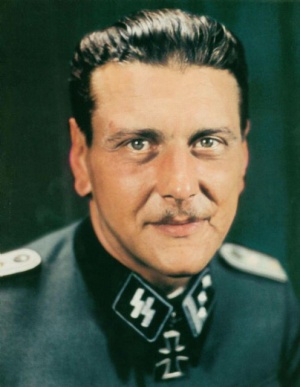Otto Skorzeny
(soldier, spook) | |
|---|---|
 | |
| Born | 1908-06-12 Vienna, Austria-Hungary |
| Died | 1975-07-05 (Age 67) Madrid, Spain |
| Founder of | Merex AG |
| Interest of | Gerhard Mertins |
A senior Nazi soldier who remained active after WWII, in touch with some of his old colleagues such as Reinhard Gehlen.
Contents
Escape from prison and alleged ODESSA involvement
Skorzeny was detained in an internment camp at Darmstadt awaiting the decision of a denazification court.[1] On 27 July 1948 he escaped from the camp with the help of three former SS officers dressed in US Military Police uniforms who entered the camp and claimed that they had been ordered to take Skorzeny to Nuremberg for a legal hearing. Skorzeny afterwards maintained that the US authorities had aided his escape, and had supplied the uniforms.[2]
Skorzeny hid out at a farm in Bavaria which had been rented by Countess Ilse Lüthje, the niece of Hjalmar Schacht (Hitler's former finance minister), for around 18 months, during which time he was in contact with Reinhard Gehlen, and together with Hartmann Lauterbacher (former deputy head of the Hitler Youth) recruited for the Gehlen Organization.[3]
Skorzeny was photographed at a café on the Champs Elysées in Paris on 13 February 1950. The photo appeared in the French press the next day, causing him to retreat to Salzburg, where he met up with German veterans and also filed for divorce so that he could marry Ilse Lüthje.[4] Shortly afterwards, with the help of a Nansen passport issued by the Spanish government, he moved to Madrid, where he set up a small engineering business. According to some allegations it served as a front for his supposed operations with the ODESSA network as he had become the Spanish coordinator.[5] On April 1950 the publication of Skorzeny's memoirs by the French newspaper Le Figaro caused 1500 communists to riot outside the journal's headquarters.[6]
After WWII
He was denazified in absentia in 1952 by a West German government arbitration board. That year he was sent by former General Reinhard Gehlen (now working for the CIA) to act as militar advisor to General Mohammed Naguib, who had just taken over the country. Skorzeny recruited a staff made up of former SS and Wehrmacht officers to train the Egyptian army. Among these officers were SS General Wilhelm Farmbacher, Panzer General Oskar Munzel, Leopold Gleim, head of the Gestapo Department for Jewish Affairs in Poland, and Joachim Daemling, former chief of the Gestapo in Düsseldorf.
Die Spinne
Using the cover names of 'Robert Steinbacher' and 'Otto Steinbauer', and supported by either Nazi funds or, according to some sources, Austrian Intelligence, he set up a secret organization named Die Spinne[7][8] which helped as many as 600 former SS men escape from Germany to Spain, Argentina, Paraguay, Chile, Bolivia and other countries. As the years went by, Skorzeny, Reinhard Gehlen and their network of collaborators gained enormous influence in Europe and Latin America. Skorzeny traveled between Françoist Spain and Argentina, where he acted as an advisor to President Juan Perón and bodyguard of Eva Perón,[9] while fostering an ambition for the "Fourth Reich" centered in Latin America.[10][11][12]
Merex AG
In 1963, he co-founded Merex AG with a former paratrooper under his command, Gerhard Mertins (who had also been in Egypt training the Egyptian army).
References
- ↑
{{URL|example.com|optional display text}} - ↑ Lee, pp. 42-43
- ↑ Lee, pp. 43-44
- ↑ Lee, p. 45
- ↑ "General Franco made me a 'terrorist': the interesting years abroad of a west of Scotland 'baby-boomer', Part 2; Parts 1964-1967", Stuart Christie. ChristieBooks.com, 2003. ISBN 1-873976-19-4, ISBN 978-1-873976-19-7. p. 92
- ↑ [1] , Time Magazine
- ↑
{{URL|example.com|optional display text}} - ↑
{{URL|example.com|optional display text}} - ↑ "Peculiar liaisons: in war, espionage, and terrorism in the twentieth century", John S. Craig. Algora Publishing, 2005. ISBN 0-87586-331-0, ISBN 978-0-87586-331-3. p. 163
- ↑
{{URL|example.com|optional display text}} - ↑ Infield
- ↑ Wechsberg, pp. 81, 116